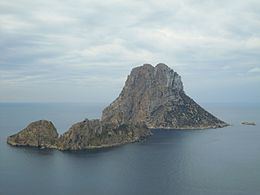Population 0 | Municipality Sant Josep Island group Balearic Islands | |
 | ||
Similar Ibiza, Cala Comte, Cala d’Hort, Playa de Ses Salines, Ses Salines Natural P | ||
Es Vedrà ([əz vəˈðɾa]) is a small rocky island of the south western seaboard of the Spanish island of Ibiza. The island, which is 413 metres tall, is part of the Cala d’Hort nature reserve and lies 1.5423 miles (2.4821 km) of the coast at Cala d’Hort, which is in the municipality of Sant Josep de sa Talaia. The island is uninhabited.
Contents
- Map of Es VedrC3A0 Balearic Islands Spain
- Es vedr trek the symbol video update 3
- Geology
- Habitation
- Legends and mythology
- The Giant of Es Vedr
- UFOs
- Francis Palau y Quer
- Es Vedr in Popular Culture
- References
Map of Es Vedr%C3%A0, Balearic Islands, Spain
Es vedr trek the symbol video update 3
Geology
Es Vedrà consists predominantly of mesozoic limestone, and contrary to the esoteric urban myth of being a special magnetic place, has no (magnetic) metal accumulations. The island we see today is as a result of a geological tumble. 155 million years ago, continuous seismic movements in the earths crust caused great shifts in the Betica Mountain Range. Eventually this caused the splitting of the range resulting in the formation of the Balearic Islands. Continued movement of the ridge which formed the islands caused portions to sheer and split away from the islands. Es Vedrà, along with the satellite island of Illa Vedranell and the Illa Tagomago, are examples of this action.
Habitation
The island has no human inhabitants, although in 1855 a Carmelite Friar by the name of Francis Palau y Quer once lived here for a short time following his exile from Catalonia. The only inhabitants today are a sub-species of wild goat, which lives on the slopes and caves of the island. There is also a sub-species of the Ibizan wall lizard on the island. It is also home to a colony of the endangered bird of prey called Eleonora's falcon.
Legends and mythology
The island is said to be home to sirens and sea-nymphs, who tried to lure Odysseus from his ship in Homer’s Odyssey. It is also thought of as the holy island of the Tanit the Phoenician lunar goddess, worshiped as the patron goddess and of fertility, who became Ibiza’s patroness. Legend has it that specific sacrifices were made to Tanit during full moons on the shore of the island.
The Giant of Es Vedrà
Es Vedrà is also the setting for one of Ibiza’s popular fables (Rondalles). Es Gegant des Vedrà (The Giant of Es Vedrà) is the tale about two brothers who, to cure their father of an incurable illness, had to go to Es Vedrà island to gather rock samphire and face the huge giant who lived on the island, huddled in one of the island's many caves. The two brothers’ ingenuity, along with the help of sea urchins, managed to debilitate the giant, and thus collect the samphire for the cure.
UFOs
Many people have claimed to have seen UFOs around the island and some believe that there is a secret UFO base under the sea here, and that Es Vedrà is their gateway or navigation beacon. One such sighting is famously known as Caso Manises. On November 11, 1979 a commercial flight between Mallorca and Tenerife was redirected to make an emergency landing in Valencia. The pilot reported a strange rapid moving light accosting his aircraft close to the island of Es Vedrà. He sent out an SOS signal and as the air traffic controller was unable to identify the object he was urged to change his flight path.
Francis Palau y Quer
The Carmelite friar Francis Palau y Quer arrived on Ibiza following his exile from Barcelona in 1855. Needing solitude, he used to retire to Es Vedrà by rowing a boat, to pray there and seek God's will. Legend says that he spent a week meditating surviving on nothing but rainwater he collected from drips from the roof of a cave he used for shelter. Within hours, he began to witness a series of powerful visions. He later described them in a book, called My Relations With the church
He started to write Mis Relaciones Con la Iglesia (My Relations With the Church), a sort of autobiographical journal, partly written in the idyllic solitude of Es Vedrà, transmitting his experience of the Church conceived as God and neighbors. Fr. Francisco Palau, O.C.D. was beatified in Rome by Pope John Paul II on April 24, 1988. His liturgical feast day is commemorated on November 7.
